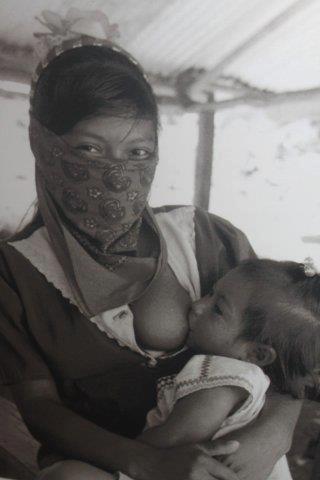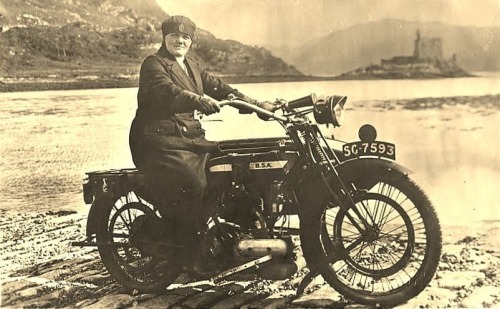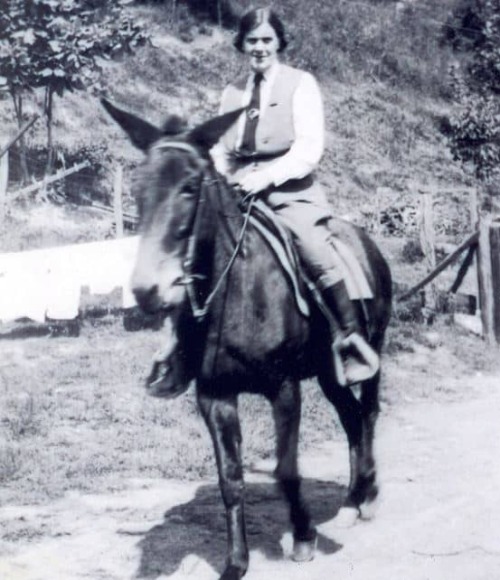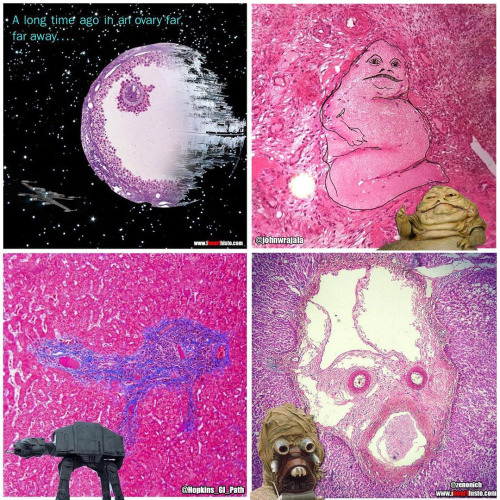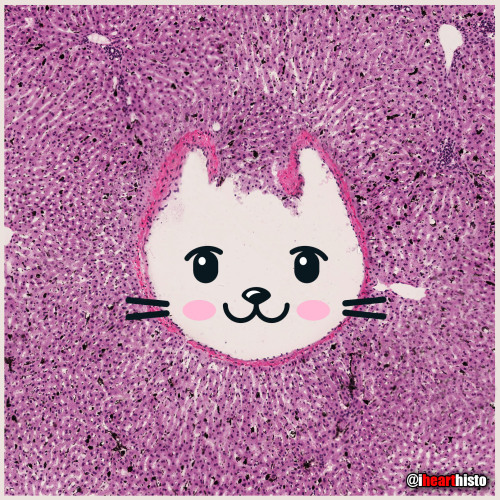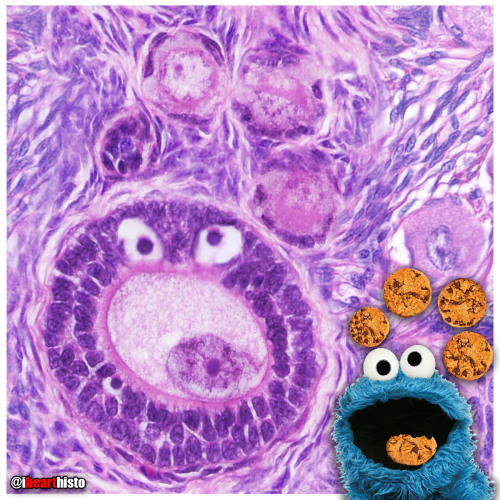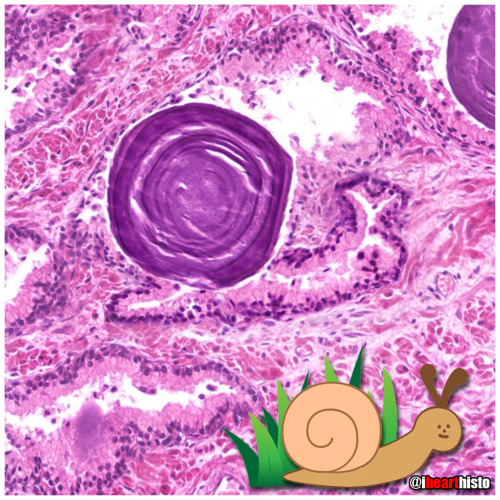#nursing
Hi guys, I just wanted to let my amazing followers know that I have switched platforms and am now on WordPress. WordPress will enable me to interact with my followers far beyond what I’m able to do here. It will also allow me to have a more user friendly for those of you who use laptops to view my blog posts rather than an application on a mobile device. A key feature that I’m very excited about is the ability to categorize my posts for easy searching. A quick tap on “Fundamentals of Nursing” will allow you to see all my posts within that category. My posts will continue to be directed to this blog with a link to view the entire post for those of you who are not quite ready to make the leap to another platform. However if you are already a member of WordPress or if it’s something you’d be willing to consider I have a link to my new blog here.Send me a message if you have any questions or concerns. I appreciate your support and I’d like to thank you for being the best followers a blogger could ask for!
In order to better understand cardiac defects, it’s best to start off reviewing how a normal heart works. First, the Superior and Inferior Vena Cava carrydeoxygenated blood into the heart (Right Atrium) from other parts of the body. The deoxygenated blood then passes through the TricuspidValve into the Right Ventricle. Thedeoxygenated blood is following the pathway through the heart in order to get to the lungs to gain oxygen, next the blood passes through the PulmonaryValveand enters the Pulmonary Artery, the pulmonary artery is special because it is the only artery in the body that carries deoxygenated blood. Once the deoxygenated blood passes through to theLungsit becomes oxygenated. The newly oxygenated blood then flows back to the heart through the Pulmonary Veins and into the Left Atrium. It then passes through the MitralValveand into the Left Ventricle. The blood is then contracted through the AorticValveinto the Aortaand to the rest of the body.

The Fetal Heart:
During the fetal period and some time after birth, the circulation is quite different. The heart has more, holes, if you will in order for the fetal blood to bypass the lungs that are unable to oxygenate blood while the fetus is in utero.
- The Foramen Ovale is an opening that allows passage of blood from the Right Atrium directly into the Left Atrium. The blood passing through is already oxygenated from the placenta.
- The Ductus Arteriosus is an opening that passes oxygenated blood from the Pulmonary Artery directly into the Aortato get pumped to the rest of the body.
Normal changes in the heart after birth:
- Ductus Arteriosus closes
- Foramen Ovale closes
- Ductus Venosus (connection from the umbilical cord) closes
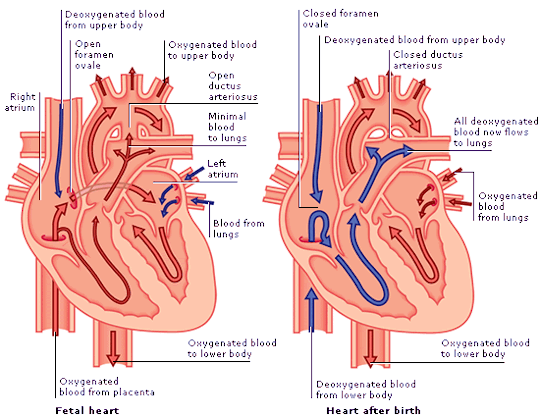
A quiet day so far for anniversaries, so I have to dig deep and create something from next to nothing,
May 12th each year is International Nurses Day.
Until the mid-nineteenth century, nursing was not an activity, which was thought to demand either skill or training. Nor did it command respect. As the English heroine of nursing, Florence Nightingale, said, nursing was left to ‘those who were too old, too weak, too drunken, too dirty, too stupid or too bad to do anything else’
The intimate body services to be done for the patient were considered to be unseemly or immodest for young unmarried or well-bred females, especially if not a family member. Cleaning and feeding of another person were regarded as domestic tasks performed by servants.
Also, before 1880, the hospital treatment of illness was fairly rare. Where home services were adequate, a sick person was attended by the family doctor and nursed either by female family members or servants. However, from the middle of the nineteenth century, the discovery and application of anaesthetics and antiseptic surgery advanced medical technique and allowed all classes to seek treatment in hospitals. From the 1860s onwards, a series of nurses’ training schools began to produce fairly large numbers of educated women who were eagerly accepted by hospital authorities whose medical officers, patients and public opinion in general were demanding higher levels of nursing skill in the wards.
In Scotland, a series of nursing schools began to produce large numbers of educated women who were then accepted to work in hospitals. This resulted in demand for higher levels of nursing skill in the wards. For Queen Victoria’s Jubilee in 1887 fund-raising efforts led to the creation of an institution that would nurse the sick poor. In Scotland, this resulted in the formation of the Queen’s Nursing Institute Scotland in 1889, based in Edinburgh. After training, nurses could be sent to work anywhere, from as far north as Shetland or down south to the Scottish Borders. This could mean serving a densely populated urban area or a rural one with vast distances between patients, such as that covered by the East Lothian Benefit Nursing Association.
Over time, nurses have been involved in wars, pandemics, daily emergencies, regular check-ups, and palliative care. There have also been numerous developments in all branches of nursing but what remains at the heart of it all is the commitment towards the promotion of health, prevention of illness, and the care of ill, disabled and dying people. Where would we be without these wonderful nurses!
Pics are from the Queen’s Nursing website, first is District nurse Elizabeth McPhee in 1926 astride her BSA motorcycle on the ferry slipway at Dornie, and yes that’s an unrestored Eilean Donan Castle in the background! Annie Mackinnon, a nurse from Roag, Skye, she went to France during ww1 and was awarded a Croix de Guerre: “for conspicuous bravery in continuing to care for the sick and wounded under enemy fire’. Queen’s Nurse (QN) Katy Shearer, Loch Fyne, 1950. Midwife Catriona MacAskill weighing a baby in North Uist, 1959 and Maryhill war nurse Louisa Jordan, made famous recently due to her name being used for the temporary hospital and vaccine centre at Glasgow’s SEC during the pandemic.
You can find more pics a history about Scottish nursing on the QNI web site here https://www.qnis.org.uk/
Post link
✨ Happy Star Wars Day ✨
May the Fourth be with you!
i♡histo
Star Wars histology from top left, clockwise:
1. The Graafian follicle Death Star
In a galaxy far, far away an intergalactic superweapon is halted in metaphase II of meiosis amid a surge in Luteinizing Hormone.
2. Jabba the Corpus Albicans
“makingsa lee ka bok pateesa… beeska chata wnow kong bantha poodoo”
(translation) “you may have been a good friend..but now you are bantha fodder”
The corpus albicans is a structure in the ovary that is formed when the corpus luteum regresses.
3. Tusken Raider in the Liver
Despite what you see here, Tusken Raiders are not native to the human liver. If you think that, then you are making a wookie mistake.
The image is actually a portal triad and demonstrates the major structures that enter and leave the liver: hepatic artery, hepatic portal vein and bile duct.
4. The Empire Strikes Back (at the Liver)
Liver histology is definitely where it’s At-At!
A region of connective tissue among the hepatocytes in the liver.
—
Images by @ihearthisto,@drjohnrajala,@zenonichand@hopkins_gi_pathrespectively
Post link

Esoph-egg-us
✅Non-keratinized stratified squamous epithelium
✅Circumscribing muscularis mucosae
✅Submucosal glands
✅Dual layered muscularis externa
It’s just not Spring until you have painted your very own Esoph-egg-us
So get cracking and I don’t want to hear any eggscuses
#histology #science #pathology #pathologists #anatomy #autopsy #eggs #easter #spring #biology #esophagus #digestive #premed #meded #nurse #nursing #medschool #medstudent #medicine #education #vetscience #vetschool #dentistry #histotechnology #histologica #histotech #histo #pathArt #sciArt #ihearthisto

Grumpy Cord
A transverse slice through a spinal cord that looks like Grumpy Cat.
Being the center of the nervous system, transmitting neural signals between the brain and the entire body and controlling independent neural reflexes…is just so awful .
The pale central face is the ‘grey matter’ and is home to the many neuron cell bodies that run through the spinal cord. The surrounding darker region is composed of the axons of these neurons as the exit, enter, ascend and descend through the spinal cord on their way to innervate muscles, or returning information about pain back from the skin, or relaying information about body position back to the brain.
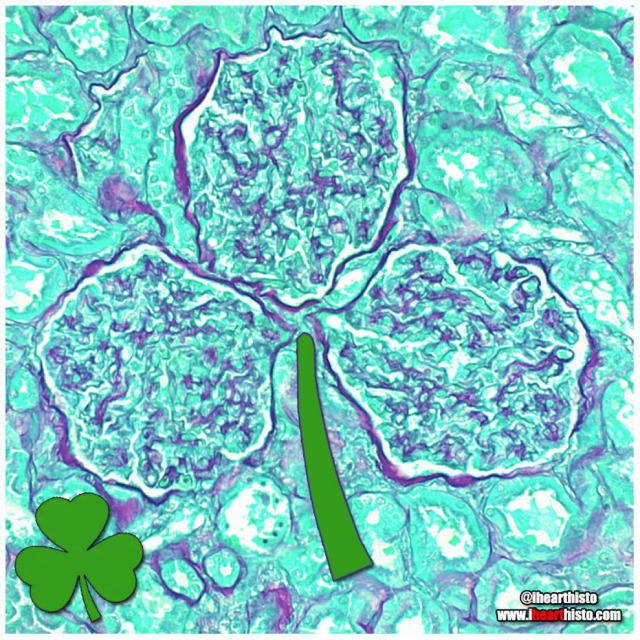
☘️Shamrock Gloms ☘️
For each petal on the shamrock,
This brings a wish your way.
Good health. Good luck. Happiness.
For today and every day.
Happy St. Patrick’s Day!
Three renal corpuscles (glomerulus + their surrounding Bowman’s capsules) floating in a sea of distal and proximal convoluted tubules within the cortex of the kidney.
These three small structures are knotted balls of capillaries (glomeruli) surrounded by a specialized epithelium (Bowman’s capsule) that is composed of cells called podocytes. These cells have tiny interlocking legs that form a small slit between them.
This structural organization is responsible for filtering your blood to produce a fluid that then travels within tubes continuous with the Bowman’s capsule called nephrons. In these nephrons the tubular fluid is modified by reabsorbing and secreting ions and conserving water to produce urine for excretion.

⚡Lord Voldermis⚡
A biopsy of a region of skin-that-shall-not-be-named (dermis/hypodermis junction shhh), complete with nerves, vessels, sweat glands and hair follicles.
by @nejiby

You can find LOVE in the strangest of places (2022 edition)
By row starting top left:
1. in a skin cylindroma
2. in an hepatic ductule
3. in a pancreas
4. in a warty penile growth
5. in a mucus-y colon
6. in a region of hypodermis
7. in a secondary oocyte
8. in a chondrosarcoma
9. in a small artery
Happy Valentine’s Day
Tag a friend with the histo heart you want to share with them and spread the love!
Images by:
@ihearthisto [1-4, 5-9]
@donna.horncastle [5]
Kitty Liver
Check meowt!
I’m a purrfect hepatic vein surrounded by hepatic lobules!
This is a hematoxylin and eosin stained slice through a liver that was injected with carbon/ink prior to fixation.
The liver is compose of numerous roughly hexagonal shaped lobules. Each lobule has a venule at its center (the central vein; top right) and a series of hepatic triads at its periphery. A triad is a collection of three structures - in this case branches of the hepatic artery, hepatic portal vein and hepatic duct.
Blood in the hepatic artery (oxygenated) and hepatic portal vein (rich in nutrients absorbed from the intestines) travels in sinusoids (the many narrow white spaces in this image) towards the central vein of each lobule. On its way through the sinusoids the blood is processed by the the many hepatocytes that line this region (the pink cells).
Within the sinusoids reside many liver macrophages (Kupffer cells) that phagocytose debris traveling through sinusoids. Normally these cells are invisible in standard H&E preparations but recall that this tissue was injected with ink! The ink was phagocytosed by the macrophages filling their cytoplasm with carbon so that they are now visible as black cells in the sinusoids.
Once the blood enters the central vein of each hepatic lobule they drain into the hepatic veins (kitty!) until the blood reaches the inferior venal cava.
In this way all blood, rich in raw nutrients and toxins absorbed from the GI tract is processed by the liver before it enters the systemic circulation!
Pawsitively unbeliverable!
Post link

Ghostface Killer is back!
Only this time he’s hiding in a rectum!
Scaring while you’re learning!
A rectal scrape is performed (more often in veterinary med) to obtain a sample of the epithelial cells lining the rectum. These are observed in the microscope for abnormal changes or for microbes and their eggs/larvae that might be present in the digestive tract.
This particular scrape contains an epithelial cell that appears to be bi-nucleate and is surrounded by red blood cells.
Cookie Monster Ovary
Today’s ihearthisto is brought to you by the letter O for Oocyte!
This is image shows a high magnification view of a slice through an ovary.
You are looking at four tiny primordial follicles (the cookies above Cookie Monster’s head) located in the outer cortex of the ovary. Each of these follicles contains a single dormant, immature egg (a primary oocyte) that is halted in the the first phase of meiosis (prophase I). Eventually these follicles will be recruited to enter the maturation cycle that, against all the odds, could see them develop into an embryo.
Cookie monster himself is a larger multilaminar primary follicle (the cookie in his mouth is the nucleus of the oocyte within the follicle). This type of follicle has already been recruited and it’s follicular cells are dividing and differentiating. The oocyte within it though is still halted in prophase I of meiosis.
An oocyte will only complete meiosis if it is ovulated and fertilized by a spermatozoon (a sperm cell).
Post link
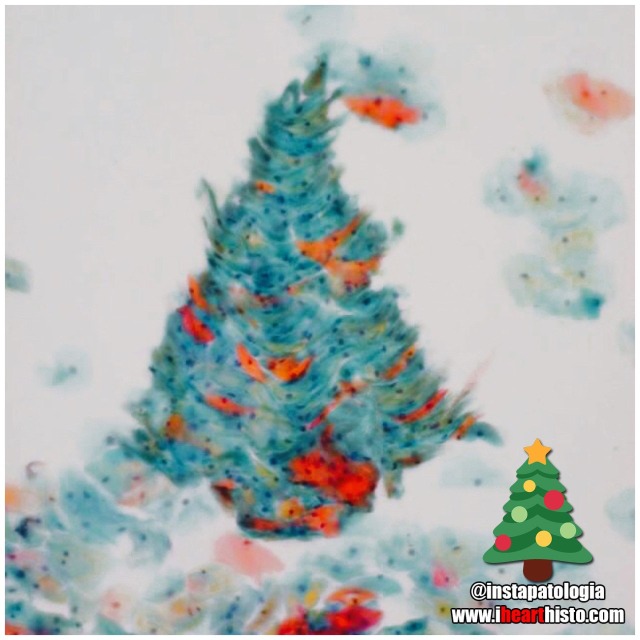
❄️Pappy Holidays❄️
There’s nothing quite like a Pap smear Christmas tree to rock around this happy holiday season!
by the awesome @instapatologia [Insta]

Rudolph the Red-Nosed Reindeer
Had a syncytiotrophoblast nose
And if you ever saw it
You would even say: “it forms the placental surface across which gases, nutrients & metabolites pass from the maternal circulation to enter the fetal circulation & vice versa”
This image shows many slices through the placental villi, fingerlike projections of the fetal-derived component of the human placenta. One of these villi looks like he’s been prohibited from participating in a variety of reindeer activities.
Rudolph’s core is composed of mesenchyme, an embryonic tissue that has the capacity to form tiny vessels (the tiny white holes) that are branches and tributaries of the umbilical arteries and vein that run in the umbilical cord and hook up with baby’s internal vascular plumbing.
The cell layer forming Rudolph’s skin (and his nose!) is called the syncytiotrophoblast layer. In the early placenta there are actually two layers (the outer syncytiotrophoblast and the inner cytotrophoblast). As the placenta matures the cytotrophoblasts thins and disappears leaving only the syncytiotrophoblast as the thin barrier between moms blood and those tiny fetal capillaries inside each villus.
But where is mom’s blood I hear you ask? Well, you can’t see it because it drained away once the placenta was removed and was sliced up. But… what you can see are the large ‘maternal blood lakes’ where her blood used to be (the large white spaces).
Now imagine all those fetal villi, and Rudolph, floating in those blood lakes and you can start to appreciate how efficient this arrangement is at allowing the exchange of gases and nutrients between mom and baby.
Prostate Snail
A secretory gastropod with a corpus amylaceum shell!
i❤️histo
This image is a close up view of a slice through the prostate gland!
The glandular portion of the prostate is composed of secretory acini that release prostatic fluid into a duct system within the gland. Prostatic fluid is a major component of semen and is rich in protein and sugar that keeps spermatozoa nourished as they travel through the reproductive tract.
The snail’s head and body are composed of the secretory epithelial cells!
The giant shell of the snail is a structure known as a prostatic concretion (corpus amylaceum or starchy body). This is a substance thought to be composed of thickened prostatic secretions and shed cells that is found in the acini and ducts of the prostate gland - it is of unknown significance.
However, these structures do increase in number with age and are a useful identifying feature of prostate in both non-pathological and pathological prostate specimens.
The space between the secretory acini is filled with a mixture of fibrous connective tissue and smooth muscle.
The smooth muscle is important because it contracts during ejaculation to push the prostatic fluid out of the gland and into the prostatic urethra where it mixes with spermatozoa arriving from the testis.
The connective tissue component is important clinically because as people with prostate glands grow older this fibrous tissue can undergo hyperplasia (excessive growth). This growth can constrict the urethra which passes directly through the prostate gland. The urethra, in addition to conveying semen during ejaculation, also carries urine during micturition/urination. This explains some of the symptoms associated with the common disorder, benign prostatic hyperplasia when urination becomes problematic for the elderly.
Post link
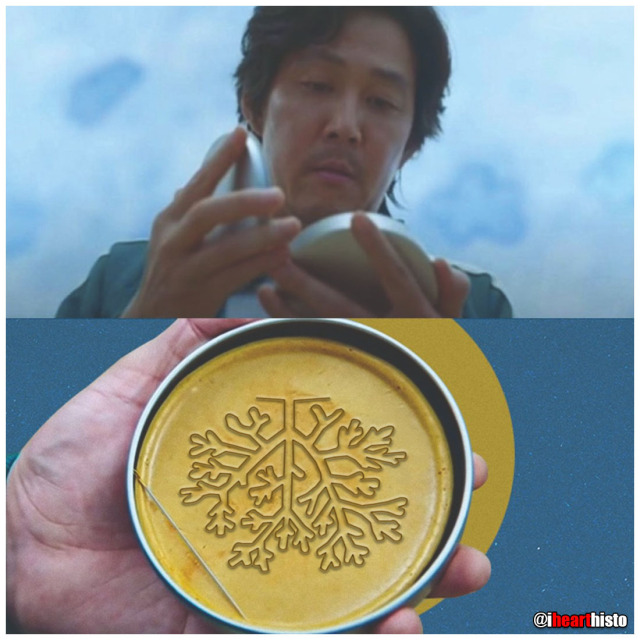
Students:
Histology:
- - - -
Those basic tissues are tough. But you have got this.

VERYSmooth Muscle
i♡histo

The Cytology Zoo
You can come too, too, too!
An exhibition of smears featuring some familiar looking squamous epithelial cell critters.
Can you recognize them all?
Cytology is the study of individual cells that have been isolated from a specimen. The technique is used mainly to study or screen for cancer but can be useful in the diagnosis of other diseases too, like those involving infectious organisms.
Most of the cells seen in a cytological smear or specimen are obtained in one of three ways:
- Scraping/Brushing the surface of a tissue (this is how cells are obtained from the uterine cervix during a pap smear)
- Collecting a fluid, this could be urine, mucus, blood or semen
- Fine-needle aspirations, this is when cells are removed by sucking them through a fine diameter needle. Fluid from the abdominal, pleural or pericardial cavities are obtained in this way and also cerebrospinal fluid during a lumbar puncture (or spinal tap).
The cells seen here are all squamous epithelial cells that are obtained from the cervix by scraping/brushing.
Credits:
@oreoimc (1-4) & (7-9)
@isac.p (5)
@sza_jhycto (6)
#histology #science #pathology #pathologists #anatomy #autopsy #zoo #animals #cytology #dentalschool #iquizhisto #premed #biology #medicaleducation #meded #nurse #nursing #medschool #medstudent #medicine #medlab #vetscience #vetschool #vetstudent #histologia #histotech #histo #pathArt #ihearthisto

Bender-scope
The microscopes of the future are all surly and a little bit hungover.
Current mood: “Bite my shiny metal a$$“

